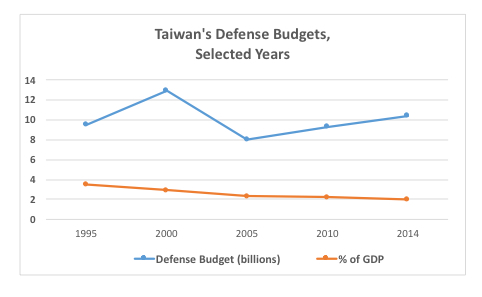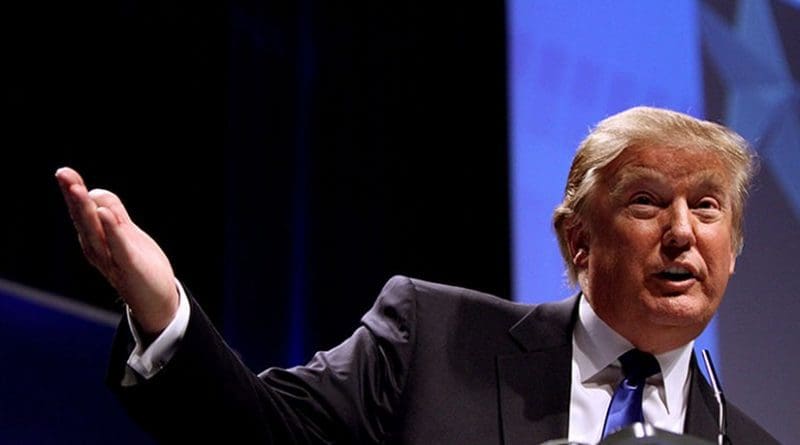Taiwan: More Than A Trump Card For US Dealing With Beijing – Analysis
Arms sales for Taiwan fit Trump’s insistence that US allies must shoulder more defense costs.
By Wenran Jiang*
President-elect Donald Trump’s off-the-cuff remarks and late night tweets have flummoxed observers. His personnel selections for the new cabinet have included both hawks and doves on China and Russia, thus sending out mixed signals on how he will handle US relations with the two world powers. His unprecedented phone conversation with Taiwan’s president has raised a storm of controversy: Is he a “child in foreign relations” as one Chinese newspaper says or a Machiavellian negotiator? Indications are that Trump is deliberately set to undo traditional US policy towards China.
After a carefully coordinated call with President Tsai Ing-wen in Taiwan, Trump now claims that his administration may not be “bound by a ‘one China’ policy unless we make a deal with China having to do with other things, including trade.”
From the Trans-Pacific Partnership, TPP, to the Paris climate deal Trump has targeted many of Obama’s signature policies, but his sharpest attacks on a foreign country have focused on China: “raping America,” “currency manipulator,” “greatest jobs theft in history,” “unfair taxes on our companies,” military buildup in the South China Sea, and not helping the US at all on North Korea.
Surprising as these comments might seem, Trump’s China policy orientation has its roots in the Obama administration. During much of his time in office, President Barack Obama pursued the “pivot to Asia,” a strategic “rebalancing” of US interests from Europe and the Middle East toward East Asia as advocated by then Secretary of State Hillary Clinton. The US strengthened its military alliance relationship with Japan and South Korea, announced deployment of the THAAD anti-missile system in the Korean Peninsula, stepped up military cooperation with Australia and the Philippines, improved relations with Vietnam and India, and repeatedly sent its navy and air force to the South China Sea – all viewed by Washington as necessary to counter China’s growing assertiveness, but seen by Beijing as measures to contain China’s rise. On the economic front, Obama took the lead in negotiating the TPP, a 12-country trading block without China and in rivalry with the Beijing-led 15-nation Regional Comprehensive Economic Partnership, so that “China doesn’t set the rules in that region, we do.”
Yet at the same time, Obama actively engaged China, from regular summit meetings with Chinese President Xi Jinping to the annual high-level US-China Strategic and Economic Dialogue.
Trump’s latest public comments and moves on China have demonstrated that he has been briefed and updated by his transition team consisting of his own and Obama officials, as confirmed by his campaign manager Kellyanne Conway. While Trump selected Iowa Governor Terry Branstad, who has maintained a relationship Xi for more than 30 years and claimed US-China relations must improve, it is far from certain that the current US-China engagement framework will continue.
What is certain is that Trump’s dealings with Beijing will begin with more confrontation, less accommodation, as China is now openly labeled as the “most important adversary” of the United States, according to Carly Fiorina, a former Republication presidential candidate now under consideration for Trump’s director of national intelligence.
Therefore, Trump’s phone call with the Taiwanese leader and his flirting with the “one-China” policy must be understood in the broader context of his policy toward Beijing. Details have emerged that some of Trump’s foreign policy advisors, including Reince Priebus, chairman of the Republican National Committee and the president-elect’s pick as his chief of staff, have close ties to Taiwan; that the Trump team lobbied to insert stronger language of support for Taiwan into the Republican election platform during the summer; and that Bob Dole, the 1996 Republican presidential nominee and a former Senate majority leader, facilitated the call as a paid lobbyist of the Taiwanese government.
While reactions to Trump’s Taiwan move have been mostly shock and concern, few have paid attention to the fact that Taiwan is more than just a bargaining chip for the United States to gain leverage with China. The island is currently the ninth largest trading partner of the United States. Since 2010, Taiwan has been the largest buyer of US arms in the Asia Pacific, totaling more than $14 billion, plus another $6.2 billion in US licenses in arms sales and services. These sales include some of the most advanced weapons such as AH-64E Apache attack helicopters, Patriot Advance Capability-3 missiles, F-16 fighters and advanced munitions.
Keeping pace with continuous arms sales to Taiwan, the US government has been quietly but gradually upgrading its military and political contacts with Taiwan while officially committed to the “one China” policy. David Helvey, a senior advisor at the US Defense Department, performing the duties of the principal deputy assistant secretary of defense for Asian and Pacific Security Affairs, recently appealed to the Taiwan government to increase its defense budget, purchase more US arms and services and have more Taiwanese companies work with the US defense sectors in order to “keep pace with threat developments” coming from China.
It is thus a logical step that the US Congress, in the newly passed National Defense Authorization Act for Fiscal 2017, authorized upgraded senior military exchanges with Taiwan in early December. This means that the US will send high level civilian and military officers, including assistant secretaries of defense and generals, to meet with their Taiwan counterparts on an annual basis.
Relations between the United States and Taiwan have been upgrading even under the Obama administration. Given that fact, Trump, along with many of his team members harboring hostility toward China, will continue to expand these military and commercial interests in Taiwan. It is worth recalling that Trump tweeted on US arms sales to Taiwan several years ago, accusing Obama of being too concerned about Beijing’s reactions. Now, more arms sales to Taiwan fit perfectly with Trump’s campaign rhetoric that US allies must shoulder more financial costs in exchange for continued US protection. Selling more arms will create jobs and promote US exports while reducing the US burden in East Asia.
In such a scenario, it is also likely that Trump will pursue a similar arrangement, modeled after Taiwan, with Japan and South Korea. Both were on Trump’s hit list during the presidential campaign for taking advantage of the United States in their alliance relationship.
If Trump gets his way, he will pressure Tokyo and Seoul to pay more for the US military bases in the two countries, short of renegotiating the existing defense treaties. And in addition to extracting trade-related concessions, Trump may also push for Japan and South Korea to buy more US arms, creating employment at home while letting Tokyo and Seoul contribute more in dealing with the North Korea threat, and balancing against China at the same time.
Now that Trump has decided to bring Taiwan back as a negotiating card in the US-China relations before he takes office, Beijing has taken a firm stand that the one-China principle is non-negotiable. Unknown is how Trump’s yet to be articulated Russian policy fits into his unfolding China game.
*Wenran Jiang is a political science professor at the University of Alberta, Canada, and a global fellow at the Woodrow Wilson Center for International Scholars.

